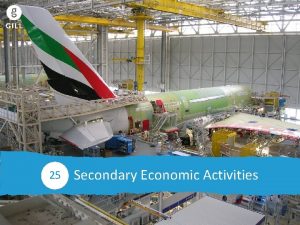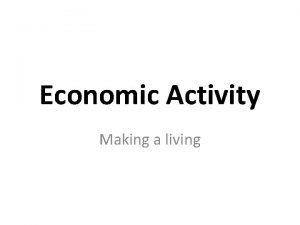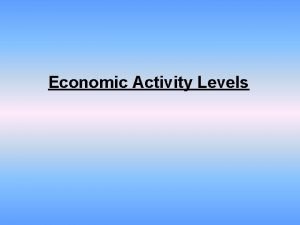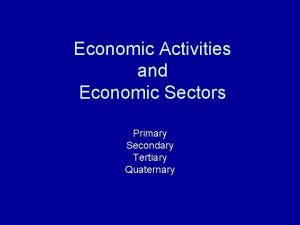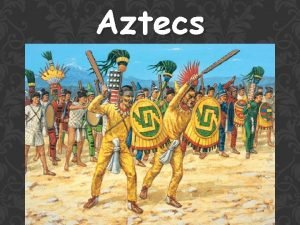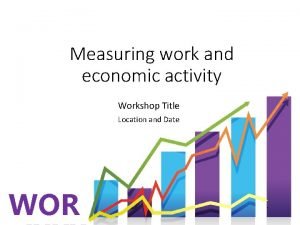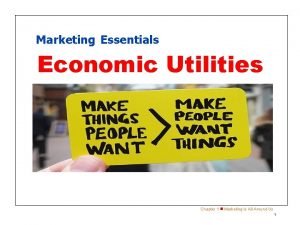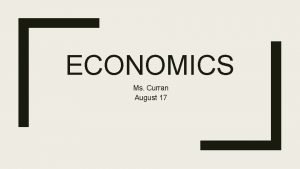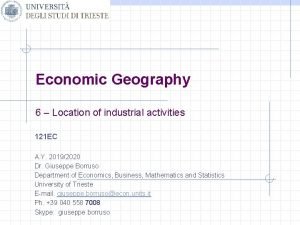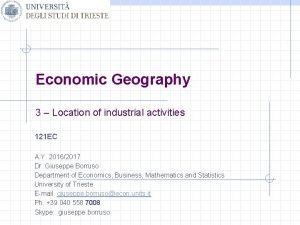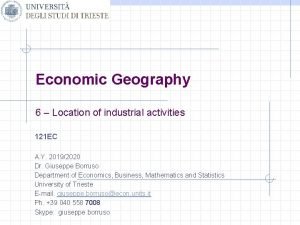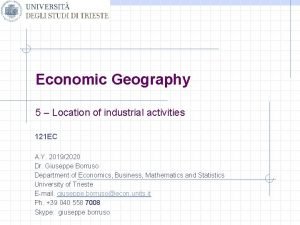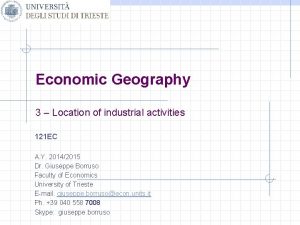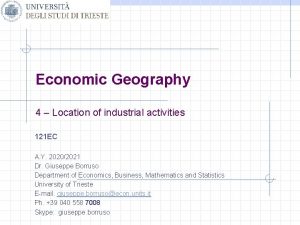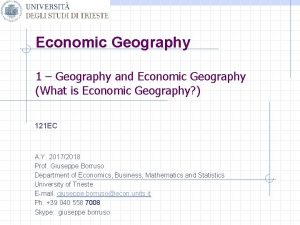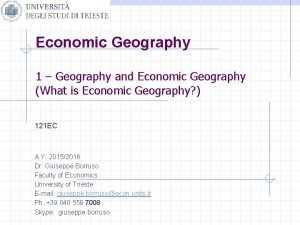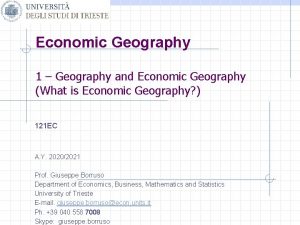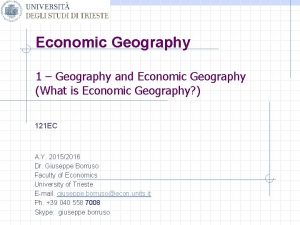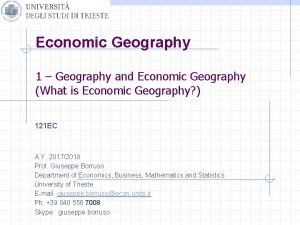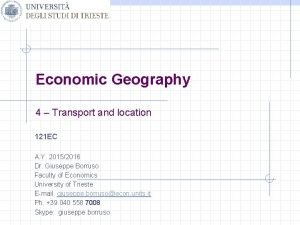Economic Geography 6 Location of industrial activities 121


















- Slides: 18

Economic Geography 6 – Location of industrial activities 121 EC A. Y. 2017/2018 Dr. Giuseppe Borruso Department of Economics, Business, Mathematics and Statistics University of Trieste E-mail. giuseppe. borruso@econ. units. it Ph. +39 040 558 7008 Skype: giuseppe. borruso

Industrial location theory Weber’s model

Weber’s Theory of industrial location w Weber’s model (Theory of the Location of Industries, 1909) w The location of all input suppliers and market are fixed and firm must choose a location that will minimize the sum of its inbound and outbound transportation costs. w Weberian models are best applied to a manufacturing firm which purchases physical quantities or raw materials, intermediate goods and fuels as inputs and produces some physical quantity of output. w Space is characterized by: n n n n Uniform interest rate; Uniform production costs, wages, rents; Uniform and proportional to distance unitary transport costs; Resources consisting of: w Localized materials (mine resources) w Ubiquitous materials (water) w Losing weight materials (raw material’s weight is only partially reflected into the final product) w Net materials (raw material’s weight is totally reflected into the final product) The model is aimed at identifying the place where to locate a firm / plant minimizing costs related to places => Raw material places Energy places Market / consumption places

Weber’s model of industrial location Location on a line w The firm uses one localized input available at a single point S on a featureless plane and sells of its output in a single market located at point M in the same plane w The production technology of the firm yields constant return to scale and allows no input substitution w Transportation costs are a constant times the number of ton-km (no terminal costs; cost per ton-km is the same for input and output; transportation is equal in all directions) w The firm is a price taker that has complete knowledge of all information necessary to accurately calculate transportation costs. Its goal is to choose the location that minimizes its transportation costs. d D-d Material source Production Facility Market S F M X = weight of unit of localized input t = transport rate in € per ton-km x = weight of unit of output D = distance SM d = distance FM D T = t. X (D - d) + txd

Weber’s model of industrial location Assembly, distribution and transport costs T = t. X (D - d) + txd Assembly cost Distribution cost TC € AC AC DC DC S M Assembly, distribution and total transportation cost for X>x S M Assembly, distribution and total transportation cost for X<x

P Weber’s model of industrial location 2 M 1= Raw material M 2 = Fuel (Energy) p 2 α 1 C = Market p 1 α 3 α 2 P 1 β 1 Locational Triangle M 2 F β 2 β 3 C p 3 Triangle of weights P 3

Alternatives: the Varignon Machine w The idea is to take a board and drill holes through all the points. Next, we hang a weight through each hole using a string. We tie all the strings together at one point above the board, and let the system balance itself out. Under unreasonable physical assumptions (i. e. , no friction, etc) the knot will be located at the one median. It is intuitively clear why this is the solution, and a formal proof is easy. Interestingly, this machine was supposedly used in real life to solve the problem in some cases.

Weber’s model of industrial location w From to w Isotims n Curves with same transport cost w Isodapane n Curves with same TOTAL transport cost

Building of the 15. 000 € isodapane from isotims referred to N and M 16. 000 € 14. 000 € 12. 000 € 10. 000 € 8. 000 € 6. 000 € 4. 000 € 2. 000 € M N 1. 000 € 2. 000 € 3. 000 € 4. 000 € 5. 000 € 6. 000 € 7. 000 € 9. 000 € 11. 000 €

Building of the 15. 000 € isodapane from isotims referred to N and M 16. 000 € 14. 000 € 12. 000 € 10. 000 € 8. 000 € 6. 000 € 4. 000 € 2. 000 € M N 1. 000 € 2. 000 € 3. 000 € 4. 000 € 5. 000 € 6. 000 € 7. 000 € 9. 000 € 11. 000 €

1. 000 € 2. 000 € 3. 000 € 4. 000 € 1. 000 € 2. 000 € 3. 000 € Building of the 8. 000 € isodapane from isotims referred to A, B and C (transport costs =) 4. 000 €

7. 000 € 6. 000 € 3. 000 € 4. 000 € 2. 000 € 1. 000 € 2. 000 € B A C 1. 000 € Building of the 8. 000 € isodapane from isotims referred to A, B and C 2. 000 € (different transport costs) 3. 000 € 4. 000 €

Weber’s model of industrial location M 1 Weber choice according to a comparison of saving in workforce and increased transport costs, (critical isodapane) L 2 (Points having higher transport costs equal to savings obtainable with lower workforce costs in locations Li) L 1 β 1 F β 2 β 3 M 2 C

1. 000 € 2. 000 € 3. 000 € 4. 000 €

Smith ‘satisfactory solutions’ w Isodapane concept w Developed by Weber w Weber’s isodapane is defined as a w w w line of equal transport cost For Smiths the isodapanes are ‘cost isopleths’ or ‘cost contours’ = lines of equal transport cost. Space-cost curve = a section drawn through the cost-contour map. The lowest point is the least cost location Spatial margins of profitability => Manufactured product sold at same price in space Points within the price envelop will host optimal (satisfactory) solutions Transport-cost surface (a) and space-cost curve (b)

Smith ‘satisfactory solutions’ A C a) B Transport – cost surface (a) and space-cost curve (b) Costs Price Area of profit b) Least cost location M O N Distances

The main elements and trends of location Production functions Author Weber Production costs (pareto optimum) Weber Production costs (Economies of scale) + Mashall Smith Perroux Porter Production costs (Economies of scale) ± ± ± Production costs (Maximization of economies of scale) ± Production costs (competitive advantages) ± Technology (homogeneous, exogenus, ± Substantially stable) Technology ± (variable, endogenous) Technology (not explicitly considered) Technology (homogeneos Low skills) ± ± Technology (variable and Highlly specialized) ± Principle externalities (ininfluential) ± space (isotropic) ± Transport (physical distance) Locational Triangle externalities (highly influential) ± space (territory) ± Transport (physical distance) Critical isodapane externalities (not Explicitly considered) ± space (territor) ± Transport (Functional distance) externalities (ininfluential) externalities (highly influential) space ± (Gravitational pole) ± ± space (spatial system) ± Transport (Hoover model) Isocost curves Maximum profit Diamond of competition

References w w w w CONTI S. , Geografia Economica, Torino, Utet, 1996 Porter, M. 1990. The competitive Advantage of Nations. New York: The Free Press. Porter, M. E. 1998. Clusters and the new economics of competition. Harvard Business Review 76 (6): 77 -90. Porter, M. E. 2000. Location, competition, and economic development: Local clusters in a global economy. Economic Development Quarterly 14 (1): 15 -34. Weber, A. 1929. Theory of the Location of Industries. Trans. Friedrich, C. J. Chicago: University of Chicago Press. Hoover, E. M. 1937. Location Theory and the Shoe and Leather Industries. Cambridge, MA: Harvard University Press. Hoover, E. M. 1948. The Location of Economic Activity. New York: Mc. Graw Hill. Isard, W. , Schooler, E. and Vietoricz, T. 1959. Industrial Complex Analysis and Regional Development. New York: John Wiley. Keeble, D. and Wilkinson, F. (Eds. ) 2000. High-Technology Clusters, Networking and Collective Learning in Europe. Aldershot: Ashgate Krugman, P. 1991. Geography and Trade. Cambridge: MIT Press. Krugman, P. 1995. Development, geography, and economic theory. Cambridge: MIT Press. Krugman, P. and Venables, A. J. 1996. Integration, specialization, and adjustment. European Economic Review 40 (3 -5): 959 -967. Marshall, A. 1890. Principles of Economics. London: Macmillan.
 The statement of cash flows helps users
The statement of cash flows helps users Indoor vs outdoor sports
Indoor vs outdoor sports Primary and support activities
Primary and support activities Primary activities and tertiary activities
Primary activities and tertiary activities A cross country skier moves from location a to location b
A cross country skier moves from location a to location b Chapter 8 location planning and analysis
Chapter 8 location planning and analysis Secondary economic activities in the west of ireland
Secondary economic activities in the west of ireland Teritary economic activities
Teritary economic activities Paris basin population
Paris basin population Secondary economic activities
Secondary economic activities Economic activities
Economic activities Levels of economic activities
Levels of economic activities Tertiary economic activities.
Tertiary economic activities. How long were the aztecs around
How long were the aztecs around Economic activities by men and women
Economic activities by men and women Economic utilities created by business activities
Economic utilities created by business activities Simplified representations of complex economic activities
Simplified representations of complex economic activities Turkey economic continuum
Turkey economic continuum Economic growth vs economic development
Economic growth vs economic development









